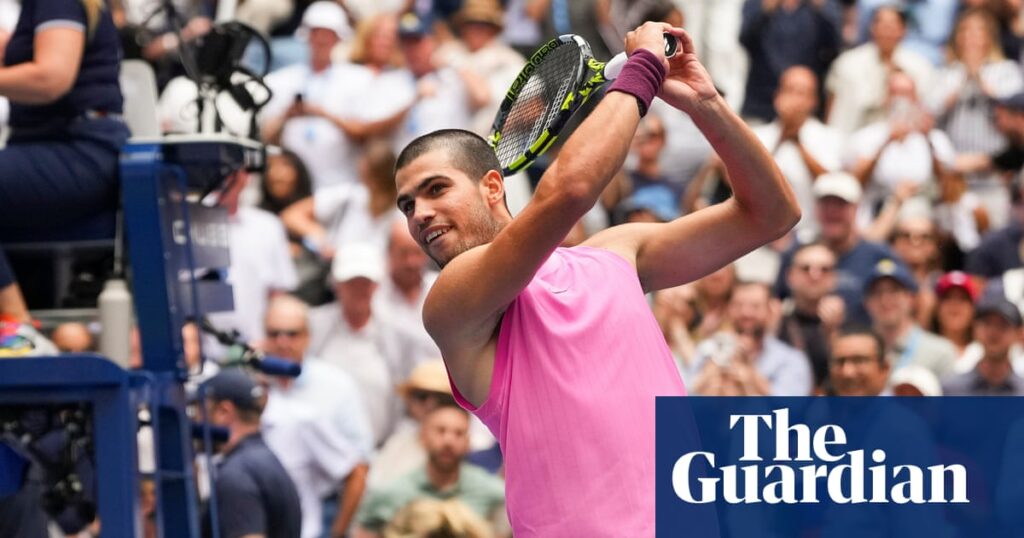Carlos Alcaraz took his final leave from Rod Laver Arena this year consumed by frustration. Losing at the Australian Open, the first grand slam tournament of the year, was painful enough, but Alcaraz’s disappointment was particularly down to how he had lost.
Novak Djokovic had visibly begun to struggle with a leg injury early in their four-set quarter-final, but instead of focusing on his own game, Alcaraz found himself staring across the net and thinking too much about his opponent’s condition rather than about what he needed to win. While the Spaniard’s focus wavered, Djokovic’s difficulties inspired his most offensive, decisive tennis, and he willed himself to a miraculous victory.
That meeting was the last encounter in what has become one of the most unusual rivalries the sport has seen. At 38 and 22 respectively, Djokovic and Alcaraz were born 16 years apart. Their first meeting at the Madrid Open in May 2022, won by Alcaraz, occurred two days after his 19th birthday and two weeks before Djokovic turned 35. Considering that significant age gap, just one match between them would have been a fortunate outcome.
Instead, when they enter Arthur Ashe Stadium for their semi-final match on Friday, they will have met on every single major stage in professional tennis: Australian Open, French Open, Wimbledon, US Open, the Olympic Games and ATP Finals. Djokovic leads their head-to-head 5-3 and those meetings have included some of the most memorable matches in the sport, from Alcaraz’s recovery to win his first Wimbledon title in 2023 to Djokovic’s career‑completing Olympic gold medal triumph last year.
The contrasting dynamics of their careers have always been at the forefront of this match, with the Serb desperately fighting to maintain his high level despite his advancing age while Alcaraz attempts to mature and grow as he moves closer to his physical peak.
This tournament has underscored both of those challenges. After spending his early years succeeding despite his wavering focus and impulsive shot selection, Alcaraz has never been more consistent. The 22‑year‑old is seeking to reach an eighth consecutive final and a third major final in a row. The confidence he has gained from an immense summer has afforded him his first run to a grand slam semi-final without dropping a set. Alongside his improved concentration and clarity of thought on each point, the development of Alcaraz’s serve into an increasingly consistent weapon has been invaluable.
Djokovic, meanwhile, has reached a point in his career where he simply does not know how his body will respond to the difficulties of trying to compete against the best players in the world across a gruelling grand slam tournament while in best‑of‑five‑sets format. His physical difficulties at the grand slam tournaments throughout this year have been clear warning signs. However, he is still performing at such a high level and he is as resilient as ever, which he reinforced with a mental masterclass in his four-set win over the No 4 seed, Taylor Fritz, on Tuesday.
On a basic level, this semi-final pits Alcaraz’s immense offensive weapons and variety against Djokovic’s ability to absorb and neutralise such attacking pressure, responding with relentless depth, direction changes and spotless decision-making. But in a match-up between two of the most complete players in history, how they adapt in the heat of battle will determine the winner. Back in Australia, Djokovic’s physical struggles left him with no choice but to attack at all costs. As he served supremely well and smothered Alcaraz with his forehand aggression, the Spaniard just did not know how to respond.
There will be moments when Djokovic tests Alcaraz’s patience and shot tolerance but, considering the uncertainty around his physicality and the No 2 seed’s efficient run through the draw, a similarly offensive-minded performance is surely the 24-time major champion’s best chance of winning. Alcaraz, of course, can dominate anyone in the world from the baseline but he will have to return better than in Australia, rein in his impulsive instincts and fare better in the advantage-court backhand battle, which Djokovic dominated in his recent wins over the Spaniard. One positive outcome for Alcaraz is that, unlike in Melbourne, they will compete in the daytime here, the livelier day conditions augmenting his unparalleled ball pace and spin.
after newsletter promotion
Things, of course, will unlikely be any easier in the final for the victor. Jannik Sinner, the world No 1 and defending champion, will take on Felix Auger-Aliassime in the second semi-final on Friday night. The Canadian has performed admirably this week, but Sinner will be heavily favoured to win.
From Djokovic’s perspective, one of the most interesting things about this period of his career is how everything has come full circle. Having spent his earlier years as the third man, tasked with taking down the duopoly of Roger Federer and Rafael Nadal, he now occupies the same position against two players born almost two decades after him. Although the odds are stacked against him – as they were 17 years ago – the simple goal is to frustrate Alcaraz and Sinner for as long as he can.


